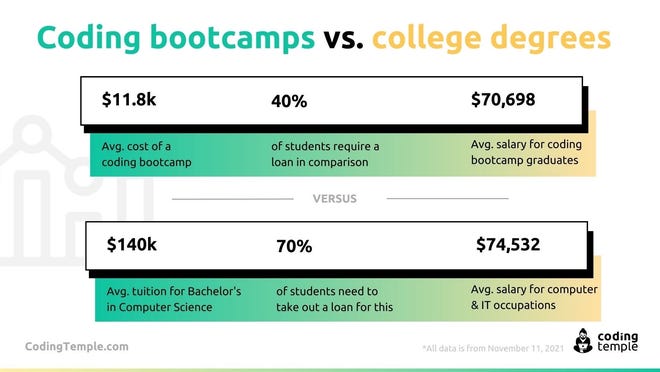
No one knows what the Supreme Court will decide on student debt cancellation, but for some people, it won’t matter. They’re already forging toward a future with little to no student debt to haggle over.
As an alternative to college, some people have gone through certificate programs — which can teach people necessary skills for a job in less time and at a lower cost than a four-year college degree. Others have found organizations like nonprofit Merit America to learn skills, or companies like Multiverse to help them find apprenticeships. Apprenticeships are meant to teach people skills they need for work without incurring a mountain of debt.
Since 2013, the number of apprentices tracked by the Department of Labor has doubled to 437,083 last year. Meanwhile, nationwide, undergraduate college enrollment dropped 8% from 2019 to 2022, with declines even after students returned to in-person classes, according to data from the National Student Clearinghouse.
Doug Shapiro, National Student Clearinghouse executive director, partly attributes the decline to students weighing the cost of college against the benefits. Students “think about what the actual cost of tuition will be,” he said, noting they’re also increasingly comparing the return on investment of different programs and need to weigh borrowing costs against their earning power.
Supreme Court decision:Everything to know about student loan forgiveness as Supreme Court focuses on Biden’s debt plan
Learn more: Best private student loans

“It changed my life,” said Halid Hamadi, who racked up $100,000 in debt studying economics at Penn State University and didn’t earn a degree because he couldn’t get a loan to cover his final semester of college.
He tried to find a way to finish, working a myriad of jobs – Subway, Jimmy John’s and as a bar and restaurant bouncer. In the end, he found Merit America and is now an integration engineer, which coordinates and implements a company’s computer applications.
These aren’t just blue-collar jobs
One of the biggest misconceptions about apprenticeships and certificate programs is that they’re only for people interested in trade jobs like plumbers, chefs, mechanics or construction workers, according to the SHRM Foundation, which helps people find apprenticeships and is partly funded by the Department of Labor. But it’s more than that. It’s also for software engineers, marketing specialists, data analysts, web developers, project managers and many more roles.
“Apprenticeship works for any program that is skill-based and that can be supported by experiential learning,” the foundation explains in its literature. “Apprenticeships are growing in non-trade industries such as IT, health care, advanced manufacturing, insurance and hospitality.”
The cost structure’s also compelling, especially when college costs are soaring and putting people into debt. A Gallup poll last year showed that 46% of parents said they would prefer their child pursue something other than a bachelor’s degree, and more than one-third cited finances as an obstacle. Additionally, just 56% of adults under age 30 who went to college said the benefits of their education outweighed the costs, according to a Federal Reserve study.
Merit America and Multiverse say no money ever changes hands up front, not even for the application.
Merit America learners might pay back for a limited time a small, set monthly payment, but only if their salaries meet certain thresholds. Otherwise, they pay nothing. People whose salaries meet the salary requirement when they leave the program usually pay around $100 monthly, much less than what college would cost, to fund the next round of learners.
For example, Merit America’s Java development program costs a maximum of $8,400 (many programs cost less and would require a smaller monthly payment). You’ll make 24 monthly payments of $350 only when you land a job making $50,000 or more. After four years, the agreement ends — even if you’ve paid nothing. If you ever lose your job, or if your income drops below the income threshold, payments pause.
Multiverse is completely free because companies and partners who value skilled workers cover the cost of training and hiring apprentices, it said.
Certificate programs run anywhere from free to about $25,000 depending on whether you’re starting from scratch or freshening skills. That compares to several tens, if not hundreds, of thousands of dollars for a four-year college degree.
Looks aren’t everything:Massive tech company layoffs look ugly. But it may not be as bad as you think.
Success without college degree:Could Steve Jobs have worked for your company? At many, the answer is no. That’s a problem.

What jobs don’t require a college degree?
A sample of high paying so-called white-collar jobs that don’t require a four-year college degree include:
- Air traffic controller. The annual median salary was $138,556 in 2021, according to the FAA. According to learn.org, the course work needed costs between $10,000 to $35,000.
- Dental hygienist. The annual average salary is $84,802, according to Indeed.com. An associate degree costs on average $22,692, according to the American Dental Education Association.
- Information technology (IT) support, automation, systems integrator and more. Tech-related opportunities are still abundant, with computer and IT professionals’ median salary hovering at $97,430 in May 2021, according to the Bureau of Labor Statistics. You can now get some certificates for free or up to a few hundred dollars while a full program costs less than $25,000.
Nonacademic credential providers, including Google, IBM and marketing giant Hubspot, now offer nearly 550,000 badges, course completion certifications, certifications and apprenticeships.
A question of fairness?:Is student loan forgiveness fair to those without college degrees? Americans remain divided over costs
Saving early for college:Seed money for college, starting in kindergarten. More cities roll out college savings plan
Last year, Google announced a $100 million Google Career Certificates Fund to support nonprofits helping youth access skills-based training and supportive services. Google estimates 70,000 Americans have completed these certificates, which are available to anyone, no college degree required.
People in apprenticeships or who already have jobs but want to update their skills also take these courses.

Tech’s still one of the biggest bangs for the buck
After examining 2,000 vacancies posted in December on LinkedIn, online learning platform ELVTR found the top five jobs that don’t require a college degree are in tech and pay between $74,000 and $100,000.

“In the world of tech, there are so many people skipping college and going to companies for immersive courses that are 10 to 15 weeks,” said Gregg Walrod, director of engineering and programs at software boot camp Coding Temple. Walrod, himself, is one of these people.
Bored with school, he dropped out of traditional high school for homeschooling, worked on the floor of Best Buy and slowly climbed the corporate ladder to manage Best Buy’s Geek Squad in China. Throughout his career, he’s taken certificate boot camp classes to continually update his skills and allow him to keep moving up the ranks at different engineering gigs.
Still having to pay:Regardless of SCOTUS decision, 25 million people will have to repay student debt. Here’s how to prepare.
Thinking outside the box:Amid crippling teacher shortages, some schools are turning to unorthodox solutions
“College has its place, and there are people like my sister who needed that structure,” he said. “But for others, college isn’t their thing.” He acknowledges, however, that to succeed, you need to be self-motivated and disciplined
A 2021 Georgetown University study showed bachelor’s degree holders earn a median of $2.8 million during their careers, 75% more than if they had only a high school diploma.
However, it’s important to note “more education doesn’t always get you more money,” Anthony P. Carnevale, director and lead author of that study, said. “There’s a lot of variation in earnings related to field of study, occupation, and other factors.”
For example, an associate degree holder in a computers and mathematical occupation has median lifetime earnings of $2.8 million, the same as median lifetime earnings for bachelor’s degree holders overall.
For Walrod, who took that chance, it was worth it. “In my 20s, I was able to take two- to three-week trips to Europe because I had no debt and a good job,” he said.
Winning outcomes for companies, people and diversity
There’s a disconnect between what many educators versus employers and young people believe college provides, some experts say.
“The challenges are that businesses are struggling to get what they need, and college in its current form is incredibly expensive and not delivering a return for people who go and isn’t creating a more diverse workforce,” said Sophie Ruddock, vice president and general manager of Multiverse North America.
Forty-two percent of employers and 45% of youth believed new graduates were adequately prepared for entry-level jobs compared with 72% of education providers, according to a 2013 global study by McKinsey.
“The education-to-employment system fails for most employers and young people,” it said. “Examples of positive outcomes in education to employment are the exception rather than the rule.”
Those are all issues these programs aim to address, program administrators and experts say. Giving people skills they can immediately use at their jobs helps companies cut training costs.
Because the programs cost much less than traditional colleges and have a flexible learning schedule, they’re also great equalizers for people, Walrod said. They serve many lower-income people, women, people of color and low-wage workers looking for a career change or an alternative path to the middle class, he noted.
Have someone else pay:Free college? Possibly, as some companies lure hourly workers with college tuition.
In dire need of skills:Surveys say: Employers leaning more into hiring those with skills versus experience
Government could also do more, said Walrod, who also mentors people interested in advancing in the tech industry.
During the pandemic, Coding Temple participated in Chicago’s free ChiCode program teaching more than 50 low-income people software skills. “Every one of those people got jobs,” Walrod said.
Coding Temple hopes to replicate that success under the Workforce Innovation and Opportunity Act, aimed at helping job seekers access employment, education, training, and support. Under thatlegislation, Chicago’s offering low-income, unemployed people financial assistance to gain skills for work. That assistance would be enough to make Coding Temple’s programs free, Walrod said.
“We have a 97% placement rate of our graduates,” he said, noting that Coding Temple offers a money-back guarantee. “If you’re actively seeking a job but can’t find one 9 months post-graduation, we give your money back.”
Medora Lee is a money, markets, and personal finance reporter at USA TODAY. You can reach her at [email protected] and subscribe to our free Daily Money newsletter for personal finance tips and business news every Monday through Friday morning.






